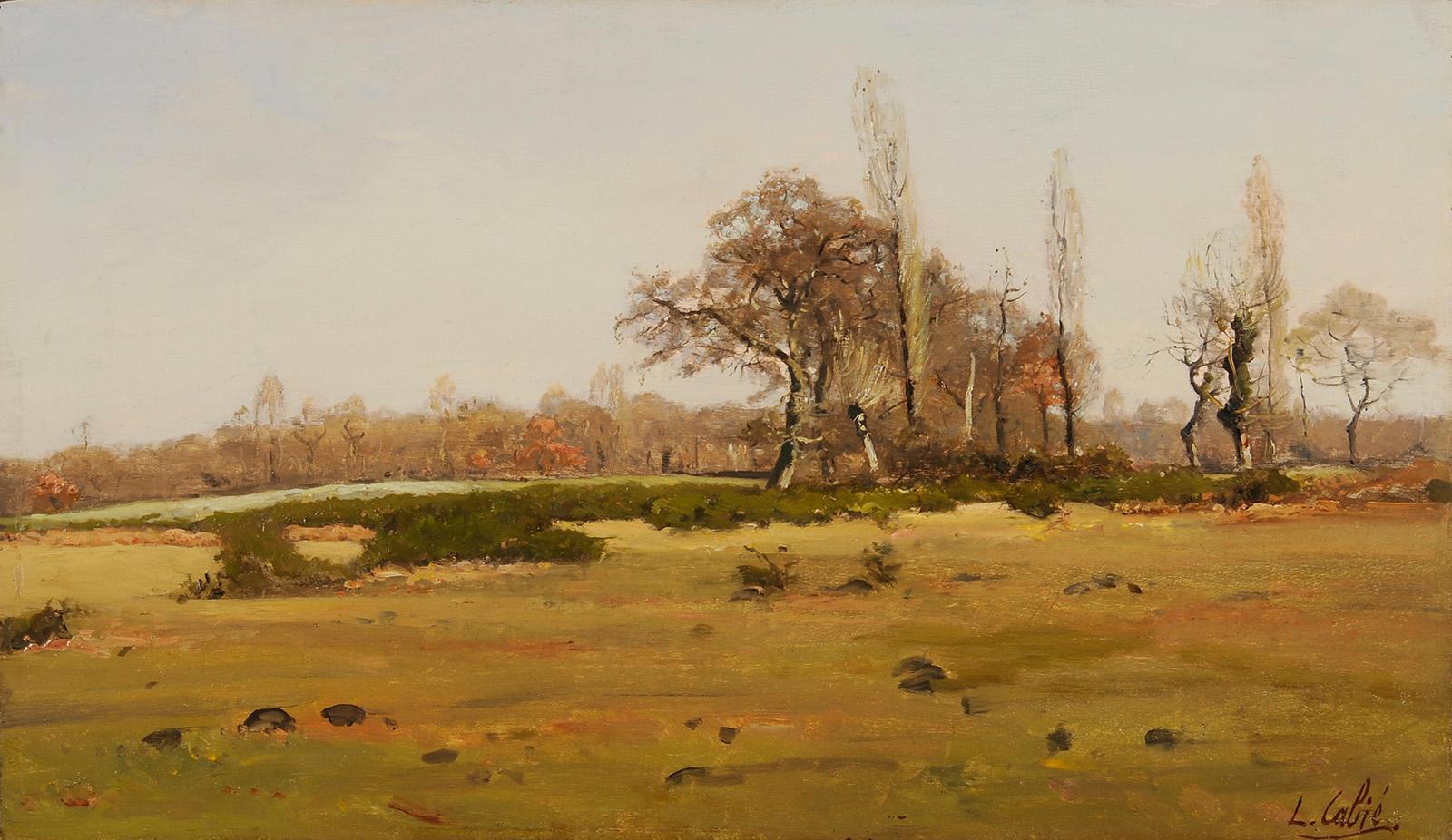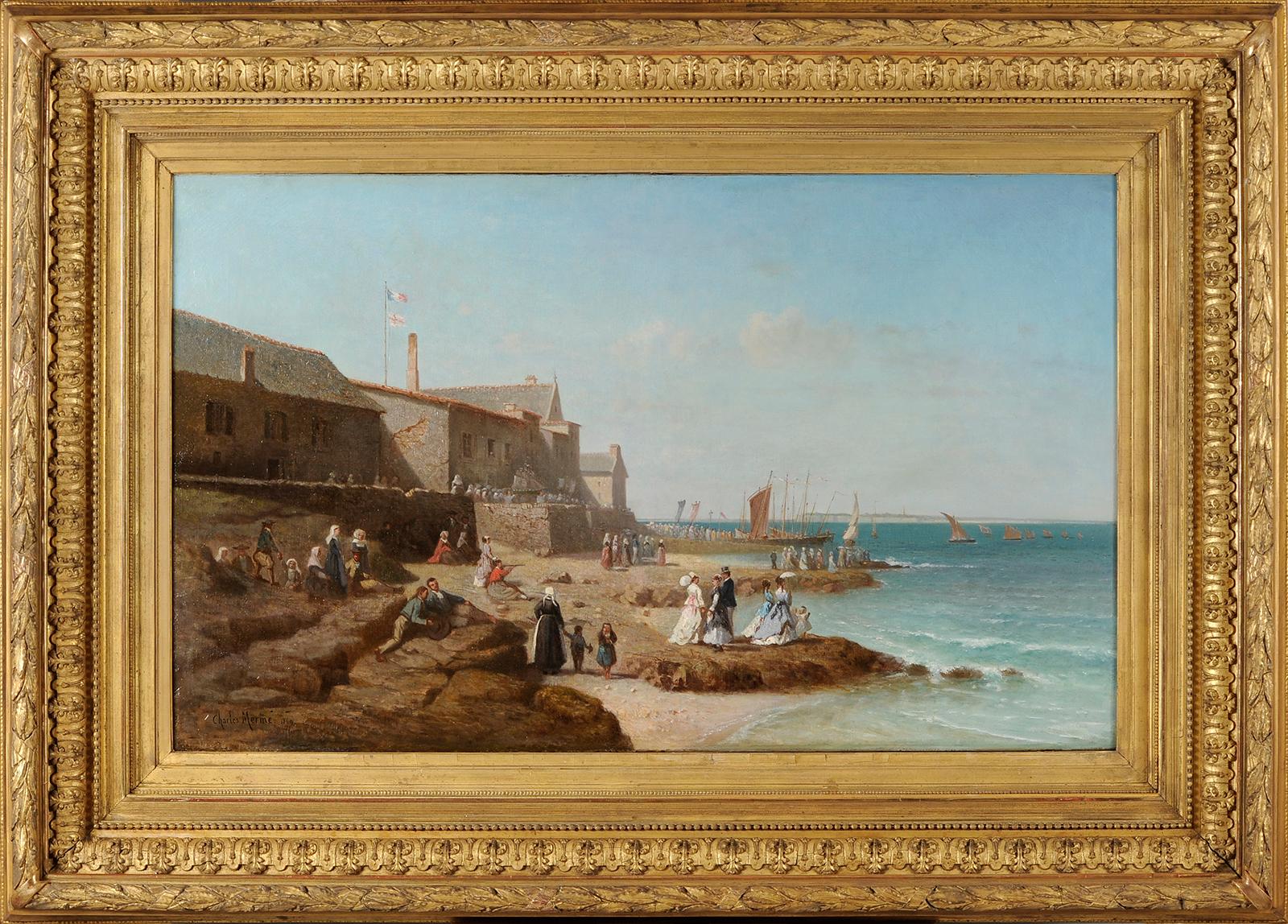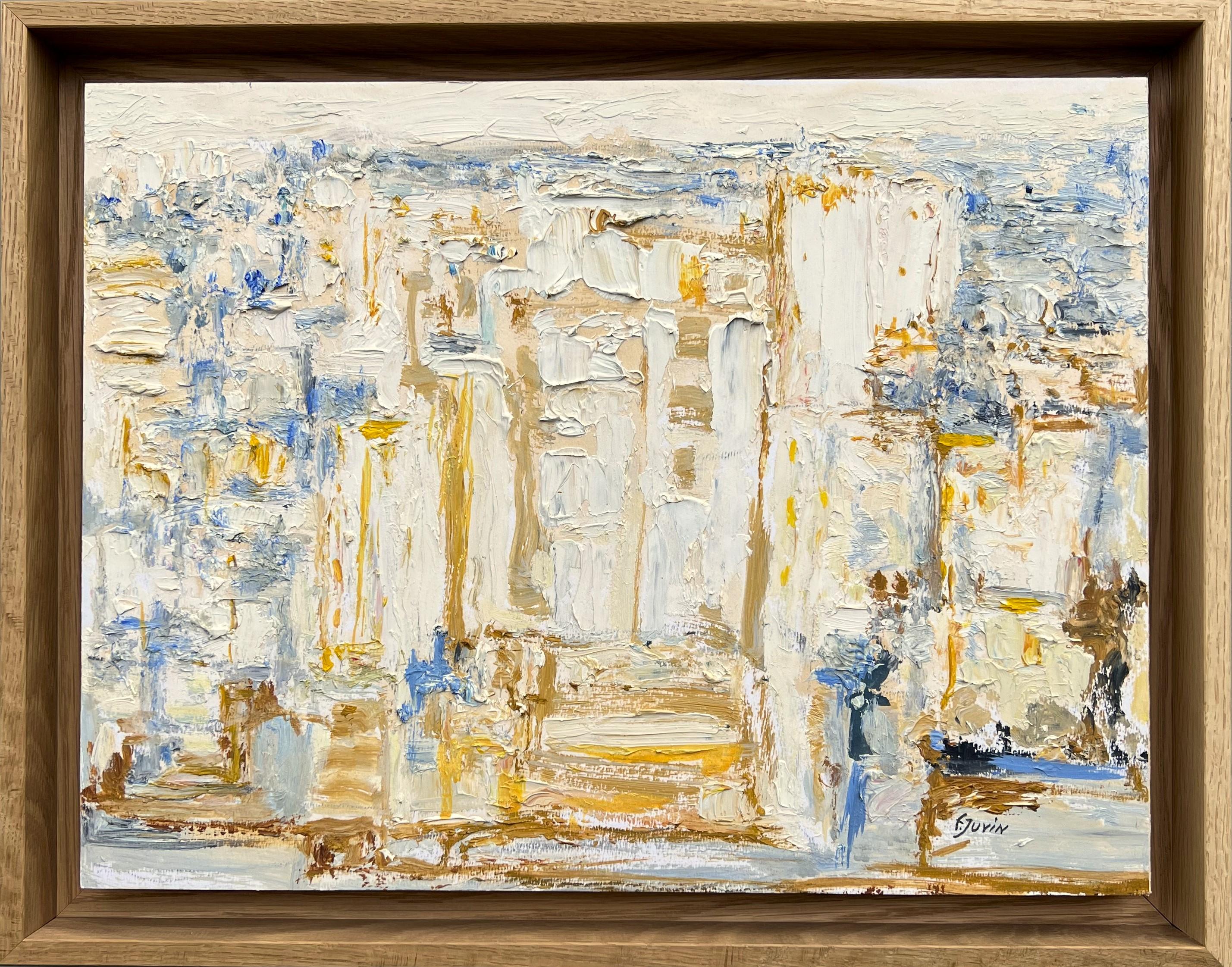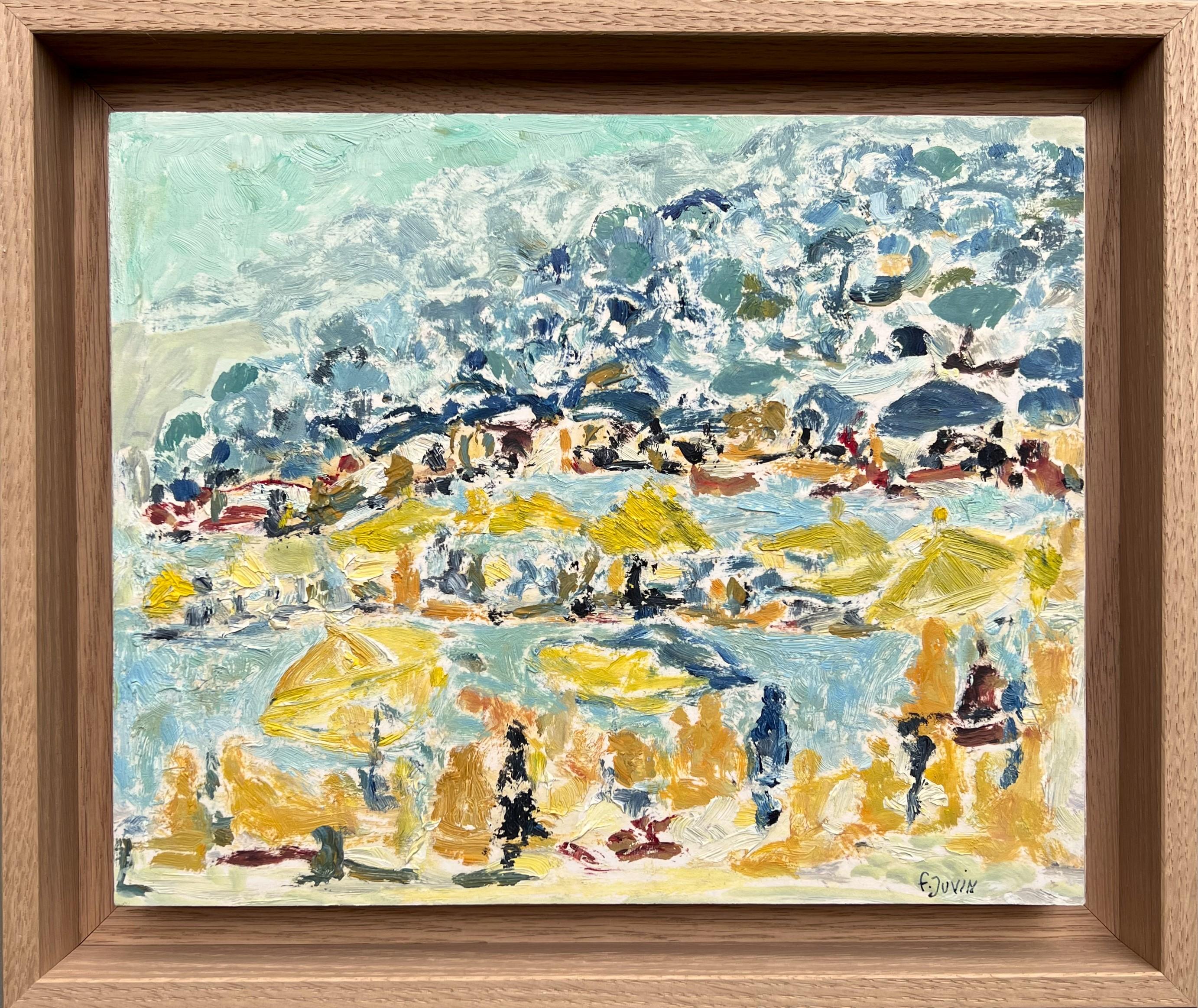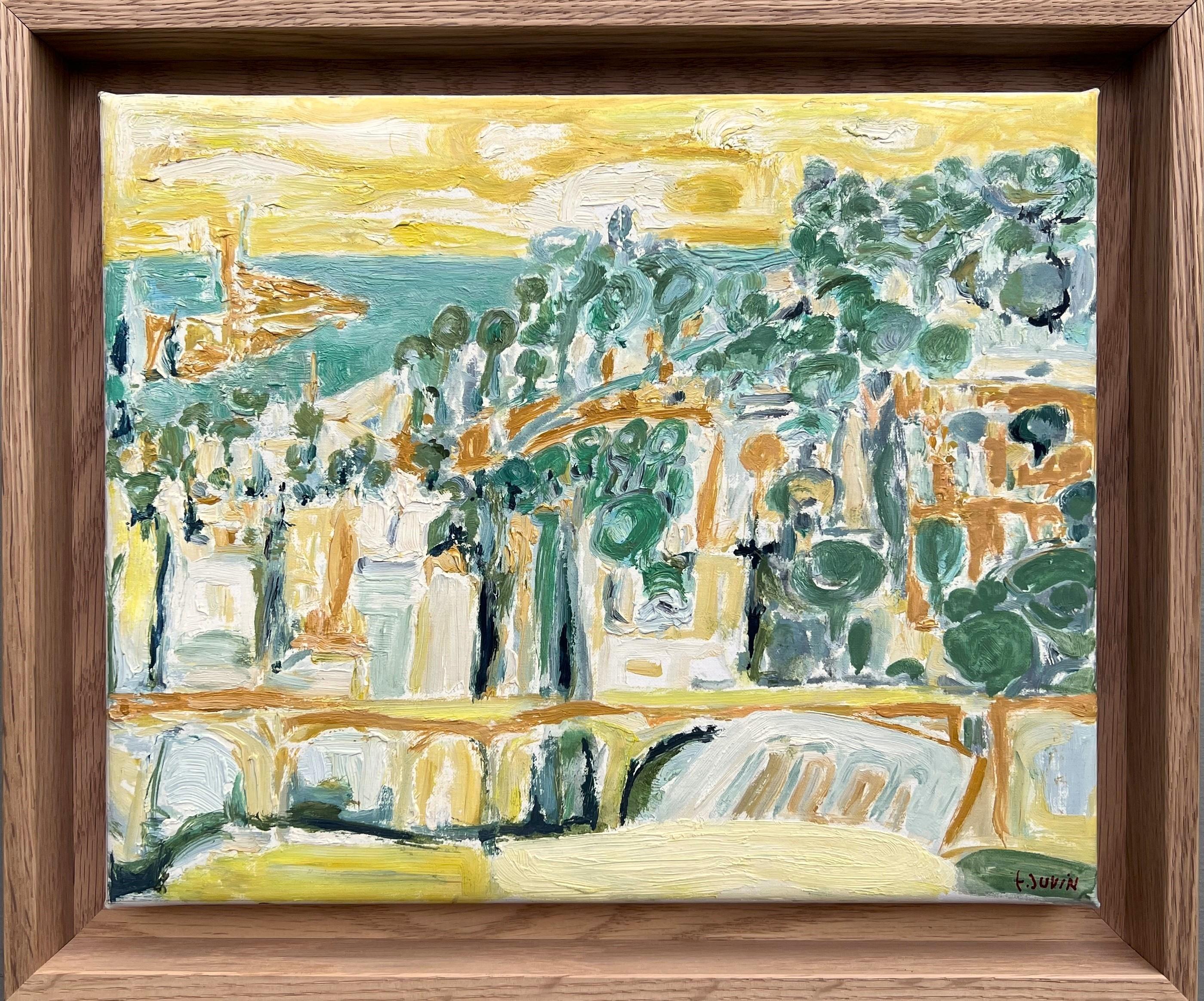Items Similar to Rocks at Belle-Ile-en-Mer, Atlantic Coast, France
Want more images or videos?
Request additional images or videos from the seller
1 of 7
Léon Charles de NovionRocks at Belle-Ile-en-Mer, Atlantic Coast, France1840
1840
About the Item
Léon Charles de Novion
(Saint-Quentin, 1792 – Saint-Philbert de Grand-Lieu, 1861)
Rocks at Belle-Ile-en-Mer
Oil on paper mounted on strong cardboard mounted on canvas
Inscription in ink on the back: "Study by my grandfather the Count of Novion in 1840 - Rochers à Belle-Isle-en-Mer"
27x36cm
1840
Son of Jean Victor de Novion (1747-1825) and Anne Le Prestre de la Moustière (1768-?), Léon Charles de Novion, Count of Novion, was born on May 29, 1792 in Saint-Quentin.
Charles de Novion is mainly known for his military career. He was successively bodyguard to the King, aide-de-camp to Lieutenant General Thiebault, aide-de-camp to Marshal de Camp Chabert, officer of the Chasseurs à Cheval and aide-de-camp to Lieutenant General Comte de Rumigny.
Parallel to his military career, Charles de Novion also devoted himself to painting according to his availability. Wounded in the knee in 1812, he remained without affectation until the return of the Bourbons and undoubtedly took advantage of these two years to devote himself to painting. He did the same in 1816, where he may have frequented the studio of Baron Gros. In 1819, as aide camp to the governor of the Invalides, he painted La toilette d’un invalide, which he exhibited at the Salon. This painting earned him a medal of encouragement. He will again be present at the Salon in 1822 with two interior scenes and then in 1824 with five landscapes and an interior scene. According to the booklet of the Salon, he collaborated that year with the artists Eugène Lami and Duval le Camus who created the characters in his paintings. He also exhibited in 1825 at the Salons of Lille and Douai various landscapes.
Married in 1826 to Henriette Rousselot de Saint-Céran (1805-1875) with whom he had three sons, Charles de Novion was made a Knight of the Legion of Honor on February 1, 1815 and raised to the rank of officer on September 2, 1843.
He died on April 23, 1861 in Saint-Philbert-de-Grand-Lieu.
- Creator:Léon Charles de Novion (1792 - 1861, French)
- Creation Year:1840
- Dimensions:Height: 10.63 in (27 cm)Width: 14.18 in (36 cm)
- Medium:
- Movement & Style:
- Period:
- Condition:
- Gallery Location:PARIS, FR
- Reference Number:
About the Seller
No Reviews Yet
Vetted Seller
These experienced sellers undergo a comprehensive evaluation by our team of in-house experts.
Established in 2014
1stDibs seller since 2022
7 sales on 1stDibs
- ShippingRetrieving quote...Ships From: PARIS, France
- Return PolicyThis item cannot be returned.
More From This SellerView All
- On the road from Subiaco to Tivoli, ItalyLocated in PARIS, FRAlexandre François LOISEL (Neuilly-sur-Seine, 1783 - Neuilly-sur-Seine, 1865) Road from Subiaco to Tivoli Oil on canvas Signed and dated lower right 50 x 60 cm 1836 Son of a rentier from Neuilly-sur-Seine, Alexandre François Loisel was born in this city on July 27, 1783. He acquired his artistic training from Louis Etienne Watelet and Jean Charles Joseph Remond. Present at the Salon from 1827 to 1845, he exhibited nearly seventy paintings...Category
Early 19th Century French School Landscape Paintings
MaterialsOil
- View of the bridge of Saint Sauveur-les-Bains, Pyrénées, FranceLocated in PARIS, FRAlexandre Louis Robert MILLIN du PERREUX (Paris, 1764 - Paris, 1843) View of the bridge of Saint Sauveur-les-Bains, Pyrénées Oil on canvas Signed and dated 1831 on the lower left T...Category
Early 19th Century French School Figurative Paintings
MaterialsOil
- Avenue du Bois de Boulogne in Paris - FranceBy Fausto GiustoLocated in PARIS, FRFausto GIUSTO (Naples, 1867 – Zurich, 1941) Avenue du Bois de Boulogne in Paris Oil on canvas Signed lower right 28 x 46 cm Fausto Giusto is an Italian painter who has built an in...Category
Late 19th Century French School Landscape Paintings
MaterialsOil
- View of Capri, ItalyLocated in PARIS, FRAugust Wilhelm LEU (Munster, 1819 – Seelisberg, 1897) View of Capri Oil on canvas Signed and dated lower right 49 x 70 cm 1882 Born March 24, 1819 in Munster, Germany, Auguste Leu...Category
Late 19th Century Academic Landscape Paintings
MaterialsOil
- On the shores of a lake in the Austrian AlpsLocated in PARIS, FRJosef THOMA (Vienna, 1828 - Vienna, 1899) On the shores of a lake in the Austrian Alps Oil on canvas Signed and dated lower right 53 x 80 cm 1877 Josef ...Category
Late 19th Century Academic Landscape Paintings
MaterialsOil
- The death of General Négrier on Place de la Bastille, Paris - FranceBy Nicolas Edward GabéLocated in PARIS, FRNicolas Edward GABE (Paris, 1814 - Paris, 1865) The death of General Négrier on Place de la Bastille on June 25, 1848 Oil on canvas Signed and dated lower right 82 x 101 cm 1849 Nicolas Edward Gabé is a 19th century artist who is still little studied to this day and yet seems to have enjoyed, according to the artistic press of the time, a certain notoriety, in particular for his seascapes. The few bibliographical elements that we have come from the Salon booklets and tell us that the artist was born in Paris in 1814, therefore shortly before the end of the Empire. No elements on his artistic training are mentioned in the booklets, we just know that Gabé exhibited at the Paris Salon from 1835 to 1864 where he first practiced miniature then then approached easel painting, risking himself as well in still life that the seascapes, the landscape, the portrait or the hunting. According to press articles, he also took part in various exhibitions in the provinces such as Boulogne-sur-Mer and Marseille. Notably, Gabé did not exhibit at the Salon his large historical canvases on the revolution of 1848, which today are of obvious documentary and iconographic interest; probably for political reasons which are easily understandable to us today in view of the historical events of then. Gabé died in Paris at the age of 51 on January 4, 1865 with a mention in the January 7, 1865 edition of L'Union des Arts: “The death of Mr. Gabé, painter, well known in the export trade in paintings as well as to the auctioneers' hotel, whose sales it supplied through its numerous navies. “ "On June 25, 1848, in front of the barricades erected in the Bastille by the insurgents of the Red Republic, General Négrier fell to death, while he was uttering words of order and conciliation". Here are the opening lines of the tribute paid by Colonel Borgarelli d´Ison, friend of General Négrier. General Négrier belonged to a family from Maine, brought back by Marshal Lannes from emigration. Born in Le Mans on April 27, 1788, François Marie Casimir de Négrier entered, barely 18, as a volunteer in the 2nd Light Infantry Regiment. He began in 1806 with the campaigns of Prussia and Poland, during which he earned, through his bravery, the rank of sergeant and the decoration of the Legion of Honor. He made the following campaigns in Spain and Portugal, and left, with his regiment, only for the campaign of France, in 1814, after having risen successively, by actions of brilliance and by a serious wound, to the ranks of head of battalion and officer of the Legion of Honor, with which he was provided from October 1813. The Restoration retained his rank in his regiment. After having fought and wounded a second time seriously in Waterloo, Négrier was recalled in 1816 under the second Restoration. He was appointed, in 1825, lieutenant-colonel, then colonel in 1830, brigadier general in 1836, and of division in 1841. From March 1837 he participated in the conquest of Algeria. The Revolution of 1848 found Negrier in possession of the important command of the 16th Military Division in Lille. Quaestor of the Assembly in these times which promised to be troubled, Négrier reviewed the Place de la Concorde on June 23 at around noon various mobile guard battalions. He then took the head of 2,000 men provided by the 10th and 11th legions of the national guard and bivouacked on the Place du Palais until the next day 24. On Sunday 25 at nine o'clock, the Négrier division resumed the fight towards the Saint suburb. -Antoine. The troop gains continual advantages. At around two o'clock the column of Négrier had seized the Pont Marie: it had removed the barricades from the Quai Saint-Paul, the rue de l'Etoile, the rue des Barres...Category
Mid-19th Century French School Figurative Paintings
MaterialsOil
You May Also Like
- Louis Cabié (1853-1939) - Landes à Pessac - GirondeBy Louis-Alexandre CabiéLocated in BELEYMAS, FRLouis-Alexandre CABIE (Dol-de-Bretagne 1853 - Bordeaux 1939) Landes in Pessac - Gironde Oil on panel H. 31 cm; L. 55 cm Signed lower right Louis Cabié, re...Category
1880s French School Landscape Paintings
MaterialsOil, Wood Panel
- Charles Merme (1818-1869) The blessing of Coureau de Groix in Larmor BrittanyLocated in BELEYMAS, FRCharles MERMÉ (Cherbourg 1818 - Lorient 1869) The blessing of Coureau de Groix at Larmor Oil on canvas H. 60 cm; W. 100 cm Signed and dated lower left, 1...Category
1860s French School Figurative Paintings
MaterialsCanvas, Oil
- François-Edme Ricois (1795-1881) View of Châteaudun castle and city in FranceLocated in BELEYMAS, FRFrançois-Edme RICOIS (Courtalain, 1795 - Mareil-Marly, 1881) View of Châteaudun Oil on canvas H. 65 cm; W. 98 cm Signed and dated lower center 1860 François-Edme Ricois although bor...Category
1840s French School Figurative Paintings
MaterialsCanvas, Oil
- View of Paris with buildings, oil painting by Françoise JuvinLocated in Montfort l’Amaury, FRFrançoise Juvin - View of Paris with buildings Reference number FJ74 Framed with a natural oak floated frame. 32,5 x 41 cm frame included (28x 37 cm without frame) This work is paint...Category
1980s French School Figurative Paintings
MaterialsOil
- Mediterranean Landcape, oil painting on canvas by Françoise JuvinLocated in Montfort l’Amaury, FRFrançoise Juvin - Mediterranean Landscape Reference number FJ28 Framed with a natural oak floated frame. 23,5 x 34 cm frame included (18 x 26 cm without frame) This work is painted with oil on a canvas. It is signed in the bottom right. Françoise Juvin (1927-2010) is a French artist born in Nancy. She entered the Ecole des Beaux-Arts in Lyon in 1941 where she met several artists such as Jacques Truphémus...Category
1980s French School Landscape Paintings
MaterialsOil
- Hilly landscape over the Rhône river in France, oil painting by Françoise JuvinLocated in Montfort l’Amaury, FRFrançoise Juvin - Hilly landscape over the Rhône river near Lyon, France Reference number FJ170 Framed with a natural oak floated frame. 24 x 32 cm frame included (19 x 27 cm without...Category
1980s French School Landscape Paintings
MaterialsOil
